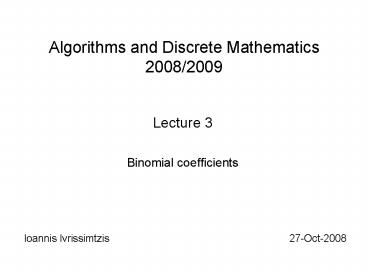Algorithms and Discrete Mathematics 20082009 - PowerPoint PPT Presentation
1 / 18
Title:
Algorithms and Discrete Mathematics 20082009
Description:
Pascal's triangle. Pascal's triangle is named after the French mathematician Blaise. Pascal (1623-1662) who studied, among other things, combinatorial ... – PowerPoint PPT presentation
Number of Views:47
Avg rating:3.0/5.0
Title: Algorithms and Discrete Mathematics 20082009
1
Algorithms and Discrete Mathematics 2008/2009
- Lecture 3
- Binomial coefficients
Ioannis Ivrissimtzis
27-Oct-2008
2
Overview
- Summary of previous lecture
- Pascals triangle
- Pascals identity
- Binomial theorem
3
Definitions
- The factorial of an integer n 0 is defined by
- and denoted by n!
An ordered arrangement of r elements of a set is
called an r-permutation.
An r-combination of elements of a set is an
unordered selection of r elements from the set.
4
Formulae
- If n and r are integers with 1 r n, then
there are - r-permutations of a set with n distinct elements.
The number of r-combinations of a set with n
elements, where n and r are integers with 0 r
n, equals
5
Overview
- Summary of previous lecture
- Pascals triangle
- Pascals identity
- Binomial theorem
6
Pascals triangle
7
Pascals triangle
8
Pascals triangle
- Pascals triangle is an arrangement of the
binomial coefficients in a - triangular array called Pascals triangle.
- The nth row in the triangle consists of the
binomial coefficients - When two adjacent binomial coefficients in this
triangle are added, the - binomial coefficient in the next row between them
is produced.
9
Pascals triangle
- Pascals triangle is named after the French
mathematician Blaise - Pascal (1623-1662) who studied, among other
things, combinatorial - problems and probabilities.
- Pascals triangle was known long time before
Pascal. Sometimes it is - referred as
- Tartaglias triangle (Italy)
- Yanghuis triangle (China)
- Khayyams triangle (Iran)
10
Pascals triangle
Arithmetica Integra Michael Stifel, 1544
Precious Mirror of the Four Elements Chu Shih-Chie
h, 1303
11
Overview
- Summary of previous lecture
- Pascals triangle
- Pascals identity
- Binomial theorem
12
Pascals identity
Pascals triangle is based on Pascals identity
for binomial coefficients.
- Pascals Identity Rosen, p.366 Let n and k be
positive integers with - n k. Then
13
Pascals identity
- Proof
14
Overview
- Summary of previous lecture
- Pascals triangle
- Pascals identity
- Binomial theorem
15
Binomial theorem
- The Binomial Theorem Rosen, p.363 Let x and y
be variables, and - let n be a nonnegative integer. Then
16
Binomial theorem
- Example 3.1
Example 3.2
17
Binomial theorem
- Example 3.3 Rosen, p.364 Expand (xy)4
18
Binomial theorem
- Exercise 3.4 Rosen, p.364 Let n be a
nonnegative integer. Then
Proof Using the Binomial Theorem with x1 and
y1, we see that































